Microservices Using .Net Core 2.X With C# and Docker
A tutorial.
Join the DZone community and get the full member experience.
Join For Free
With increasing business demands, we now develop very large and complex projects that take more time to build and deploy. Whenever QA reports any issue, we need to debug or fix it and then deploy the whole code. To reduce these complexities, most organizations are moving towards Microservices development and Docker for easy deployment and smooth service running.
You may also like: What Is New in .NET Core 3.0?
This article on microservices is focused on what “Microservices” are and their advantages over monolithic services architecture. A Step by Step procedure to develop Microservices using .Net Core 2.2 framework with C# and Docker. Use Visual Studio 2019 Preview as the IDE.
Agenda to cover this article:
What are the lists of software required for Windows?
Why should we use Microservices instead of a monolithic approach?
Why should we use .NET Core?
Why should we use Docker?
How to create Microservices using .NET Core 2.2 with C#?
How to build, tag and run the Microservices using Docker Container under multiple environments?
What Are the Lists of Software Required for Windows?
- Visual Studio 2019 preview.
- .NET Core SDK 2.x (on the current article we have used version — 2.2).
- The stable version of “Docker for Windows” (for development we have used Linux OS), Make sure Hyper-V should be configured and enabled on your local machine for virtualization as development purpose.
- Docker Tools (Kitematic).
- Swagger or Postman client tool to test API (services).
- Non-Relational Database – Cloud SQL as PostgreSQL 11.0 [in case required].
Why Should We Use Microservices Instead of a Monolithic Approach?
- Microservice is an approach to develop small services that run each in its own process. We should develop micro-services instead of one service (a monolithic approach) because of its loosely coupled nature.
- Microservices are independent services directly calling their own database. Whereas in monolithic architecture, the database remains the same for all the functionalities.
- Cleaner code, Easy to Maintain, Unit test and Code reuse.
- Below is a diagrammatical difference explanation:
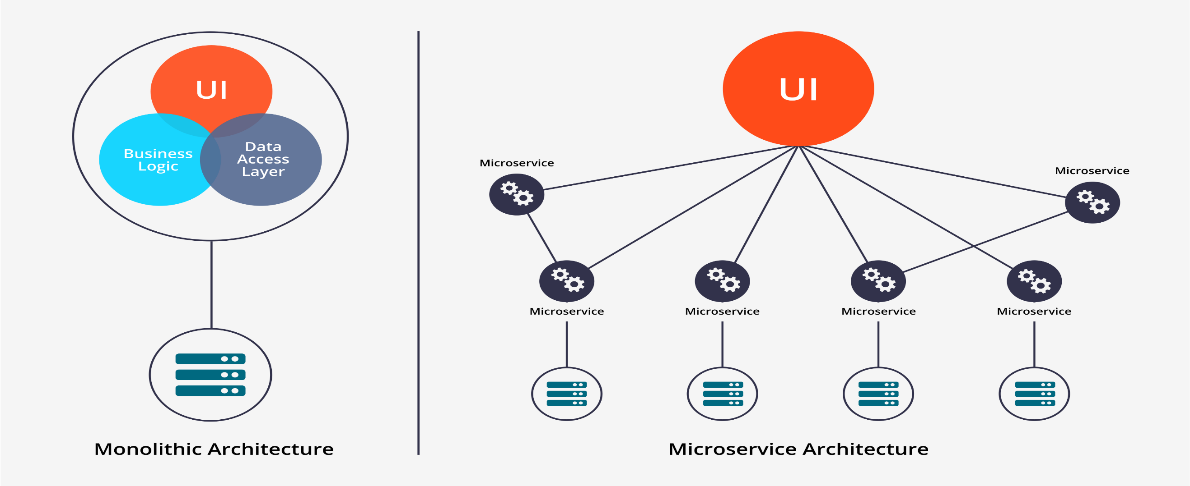
Why Should We Use .Net Core?
- It’s open-source and is very helpful in developing high-performance and scalable systems.
- It supports cross-platform runtime.
- .NET Core is also helpful for faster development, as well as supporting built-in dependency injection and a cloud-based environment configuration.
- .NET Core also has Docker support.
Why Should We Use Docker?
- Docker is a tool that makes it easier to create, deploy, and run applications by using a containerization approach. It is lightweight in nature and takes less time to start than traditional servers.
- It also helps to increase performance and cost-effective.
- You no longer need to pre-allocate RAM to each container.
How to Create Microservices Using .Net Core 2.2 With C# and Then Build and Run It Using Docker?
To start with the creation of micro-service we have implemented the Repository Design Pattern. You can go for both Multiple Repositories pattern and then capsule it in a Unit of Work pattern, just to avoid the complexity of code standards.
Data access logic is in a separate class, or sets of classes called a repository, with the responsibility of persisting the application’s business model.
Step One
Open the Visual Studio IDE and create a new web application project. Select “ASP.NET Core Web Application” as the project framework template i.e. DotNet Core 2.x, which supports cross-platform with C# language.
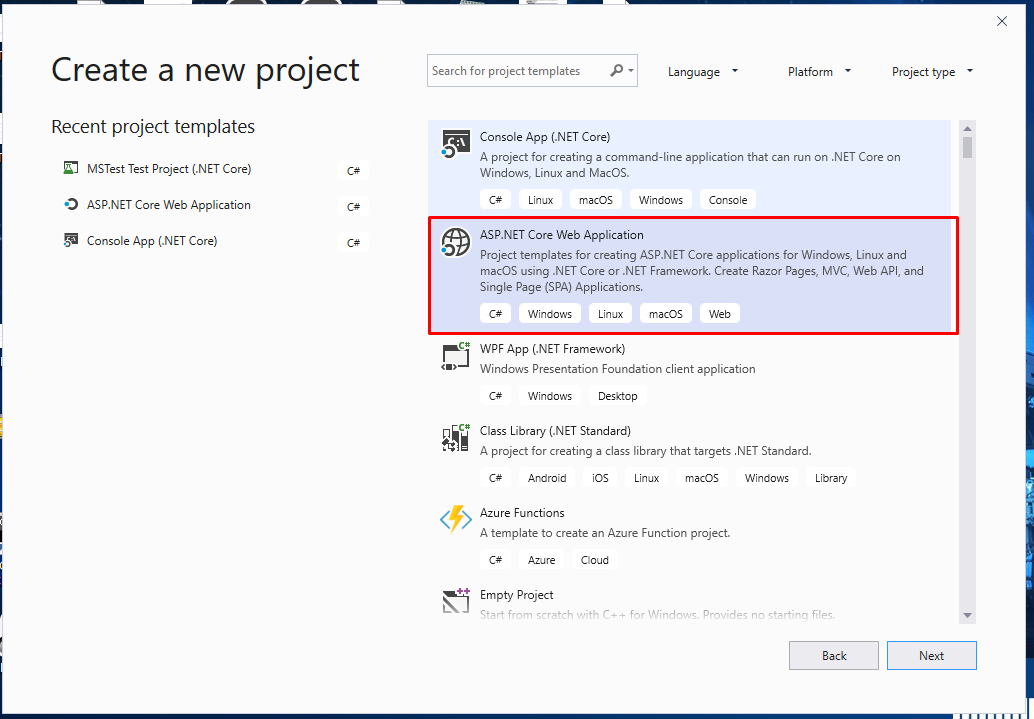
Step Two
Select the “API” option and in the Advance section select “Enable Docker Support”, “Configure for HTTPS” with no Authentication which will create respective files and docker files into the project.
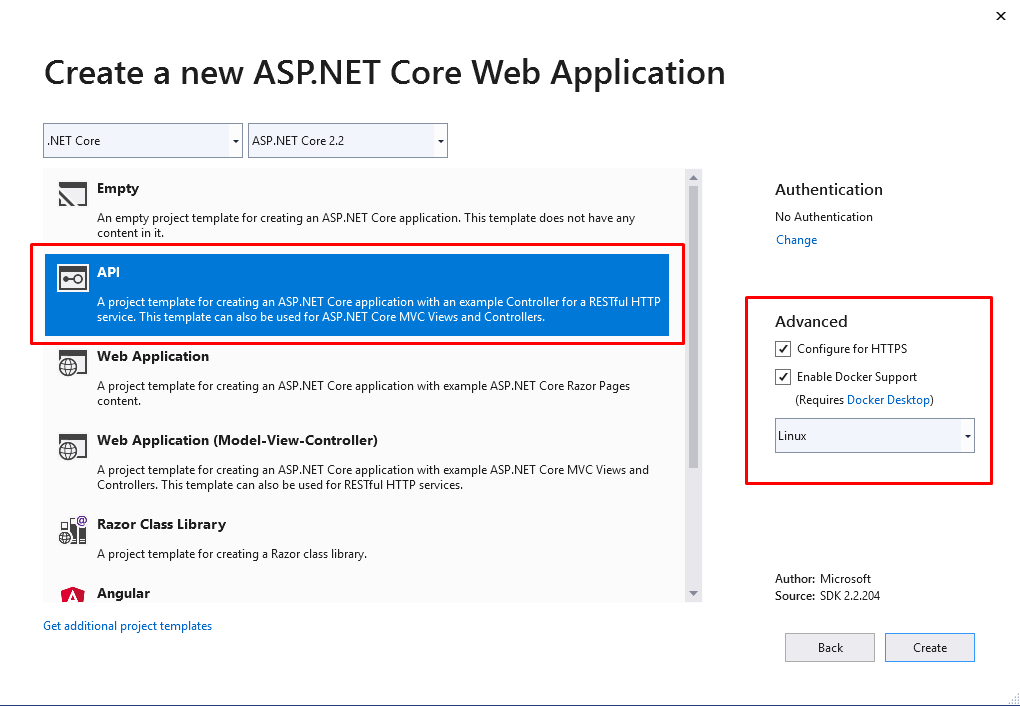
Why we selected API is because we have to create Restful HTTP service with Controllers example. This template helps to create micro-service in general.
No-Authentication by default, because we are going to create API services, so not required.
Enable Docker Support is to create Docker files, this Docker file will help to create images and then later containerize in the cloud. Currently, we have chosen LINUX as a targeted Docker OS.
Configure HTTPS is to expose the API service as HTTPS secured layer, TLS/SSL configuration required whenever we want to deploy in the actual PROD environment.
Step Three
Respective folders will get created by the help of templates chosen, Then manually create new folders as “Models” and “Repository” for dbContext object as database connectivity.
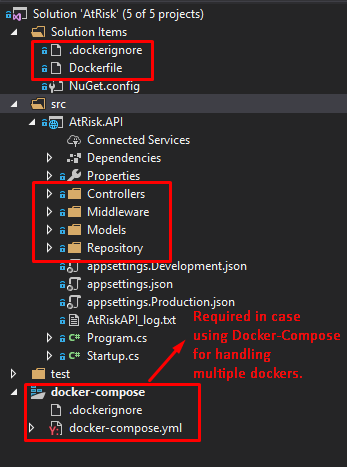
So, the above steps mentioned are the basic generic way of creating and start working on micro-services. On later steps we will concentrate on each folder and their significance of code-snippets. As an example, I will display one of my micro-service “At-Risk” and expose as an API service. Like-wise we have created several such API services and exposed them based on our business requirement.
Step Four
Development is divided into the below sections:
Creating Models
Context Class
Setting Up Database Connection
Repository Design Pattern Logic.
Dependency Injection of Repository.
Implementation in Controller.
Run the Microservice (Postman, Swagger, IIS express).
Creating Docker File, Image and run the containerized service.
Creating Models
Model classes represent the Tables and fields inside the database and will serve to map the data from the database. We have created the “Models” folder. Create a New class “AtRiskHistory” into Models folder and create properties that will map with Database table columns.
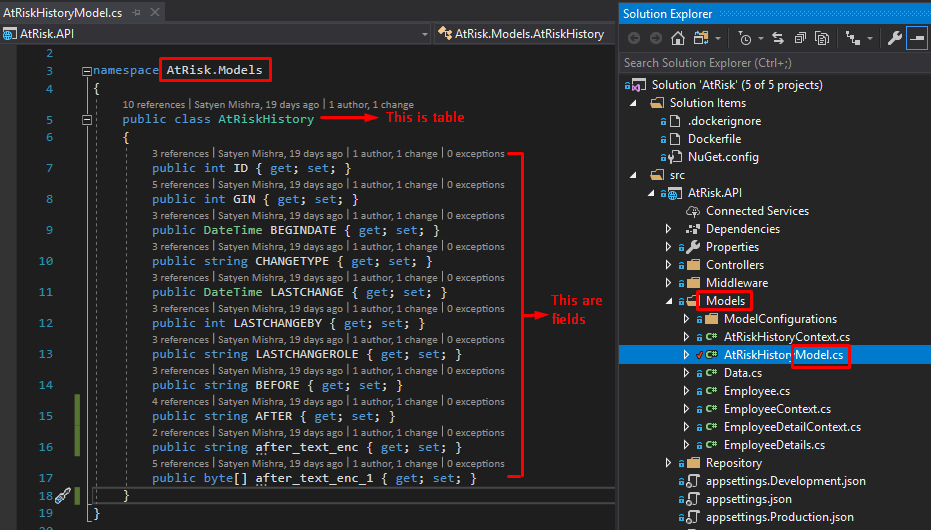
Context Class and the Database Connection
Now, let us create the context class, which will be a middleware component for the communication with the database. It has DbSet properties that contain the Table’s data from the database.
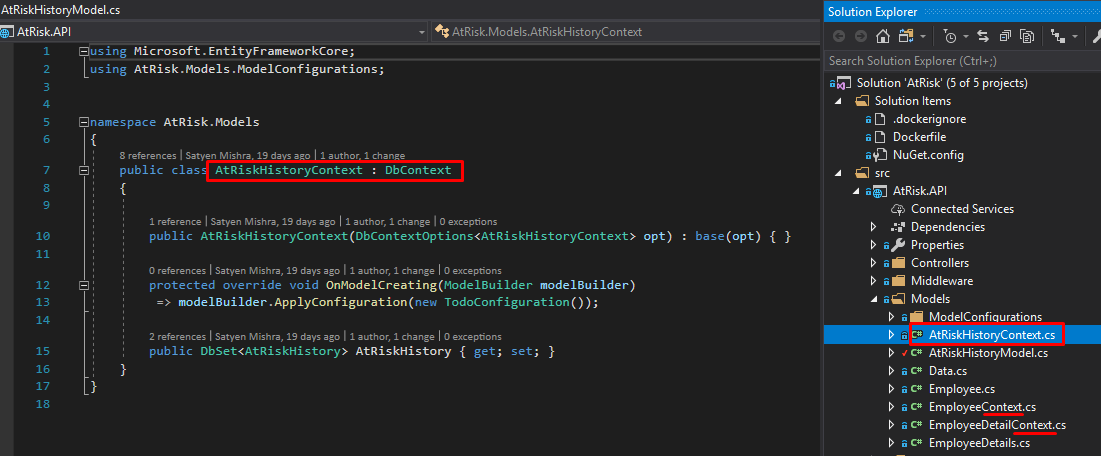
To enable communication between the .NET core and the PostgreSQL database, we need to install a third-party library. In the main project, install it either through the
1) Project > Manage NuGet Packages or 2) Tools > NuGet Package Manager > Package Manager Console, as shown below:

Below is the output of packages installed viewed at .csproj file:

Setting Up Database Connection
Open the appsettings.<Environment>.json file and add DB connection settings. Ideally, we should use the Environment Variable Configuration approach. This is easy to maintain and deploy. In this example when you are dealing with Development environment approach for appsettings.Development.json.
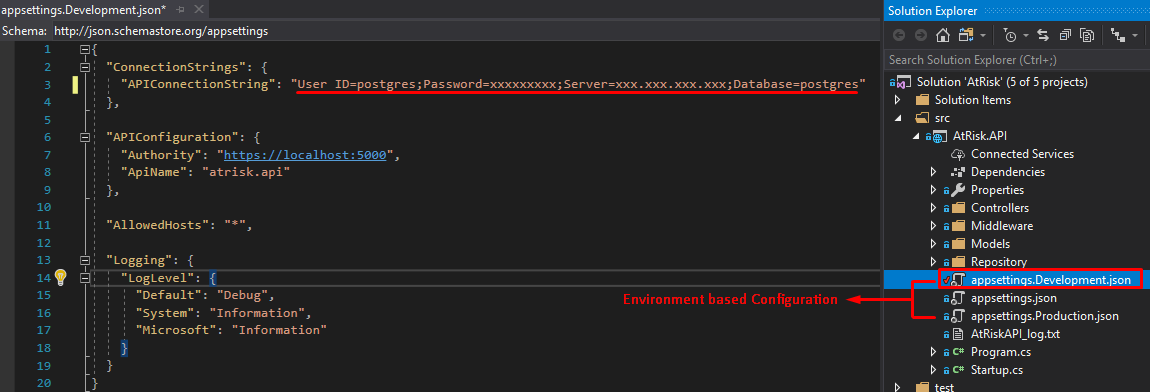
Repository Design Pattern Logic
[We have skipped the Unit of Work DP]
Create the generic repository that will serve us all the CRUD operations with SaveCommitAll method (Ideally, the SaveCommitAll should be achieved by Unit of Work Design Pattern as a best practice).
Now all the methods will be invoked by any repository class in your project and in any Controller class, we can invoke the repository logic. To build the logic first, let’s create an “Interface” for the repository inside the Repository folder. Right after the Interface creation, we will create a new Class into the Repository folder. We use Inheritance and then inherit the Repository Class with the IRepository interface. We write our business logic into the Repository class.
Create a new Interface IAtRiskHistoryRepo and define a method GetAtRiskEmployeeDetailsAsync
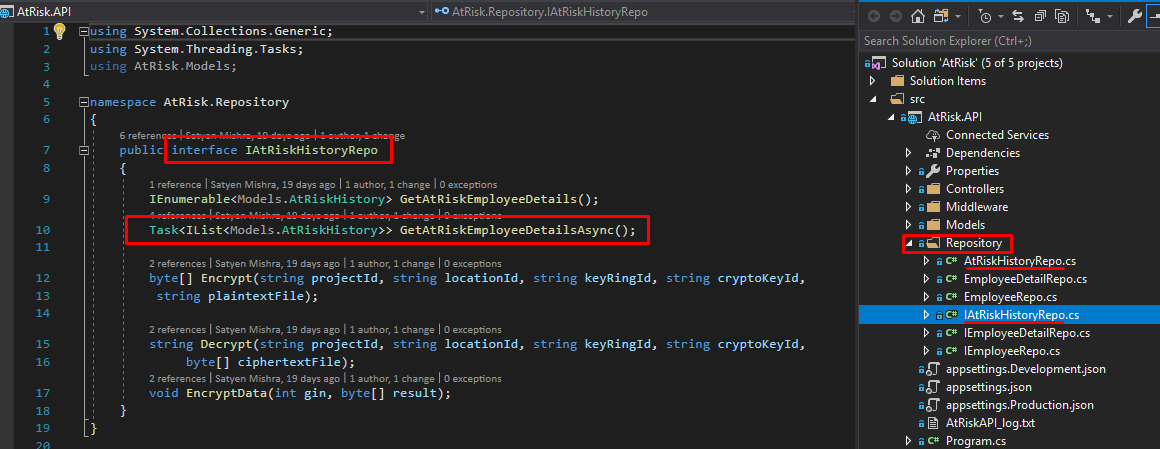
Create a new class AtRiskHistoryRepo into the Repository folder which will implement IAtRiskHistoryRepoInterface. Then write business logic for GetAtRiskEmployeeDetailsAsync method.
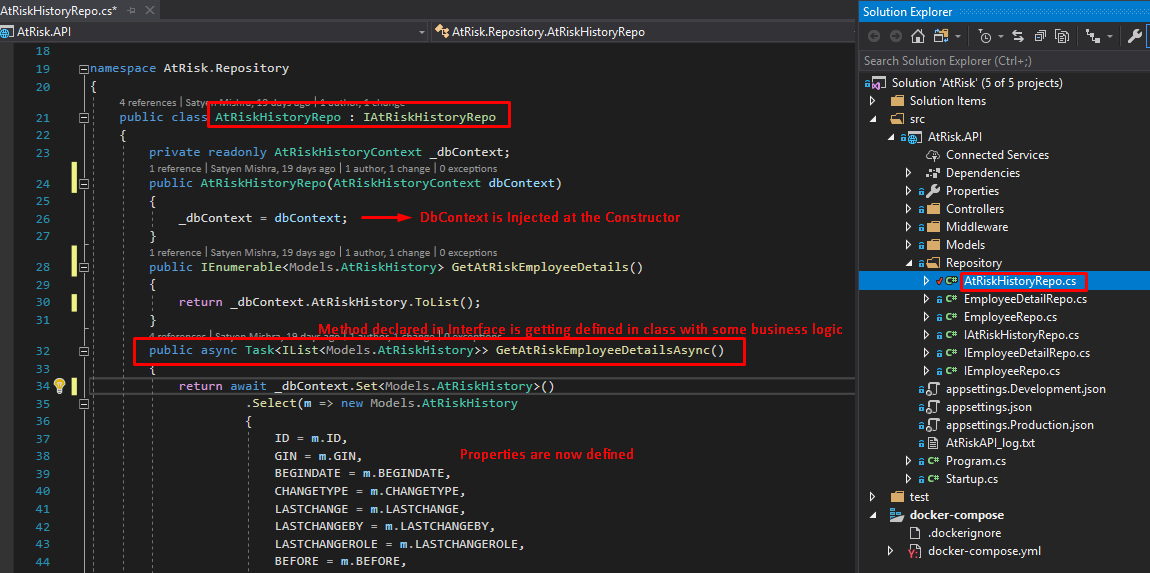
Note: Repository works as a micro component of micro-service that encapsulates the data access layer and helps in data persistence and testability as well.
Dependency Injection for Repository
We know .Net Core supports built-in dependency injection and cloud-based environment configuration, so keeping this in mind lets add Dependency Injection of Repository Class and Interface into .Net core projects.
Open the StartUp.cs file and add the code i.e. to inject the service as like:
services.AddTransient<IAtRiskHistoryRepo, AtRiskHistoryRepo>(); etc...
and few PostgreSQL configuration’s snippets inside the ConfigureService method so that the repository’s dependency is resolved at run time when needed and establish PostgreSQL DB Connection.
If you see, in StartUp class we have no were mentioned any sensitive data, everything is environment variable configuration based like used for DB connection. Always keep this best practice to not mention any sensitive or secrets in code solution when dealing with the PROD environment.
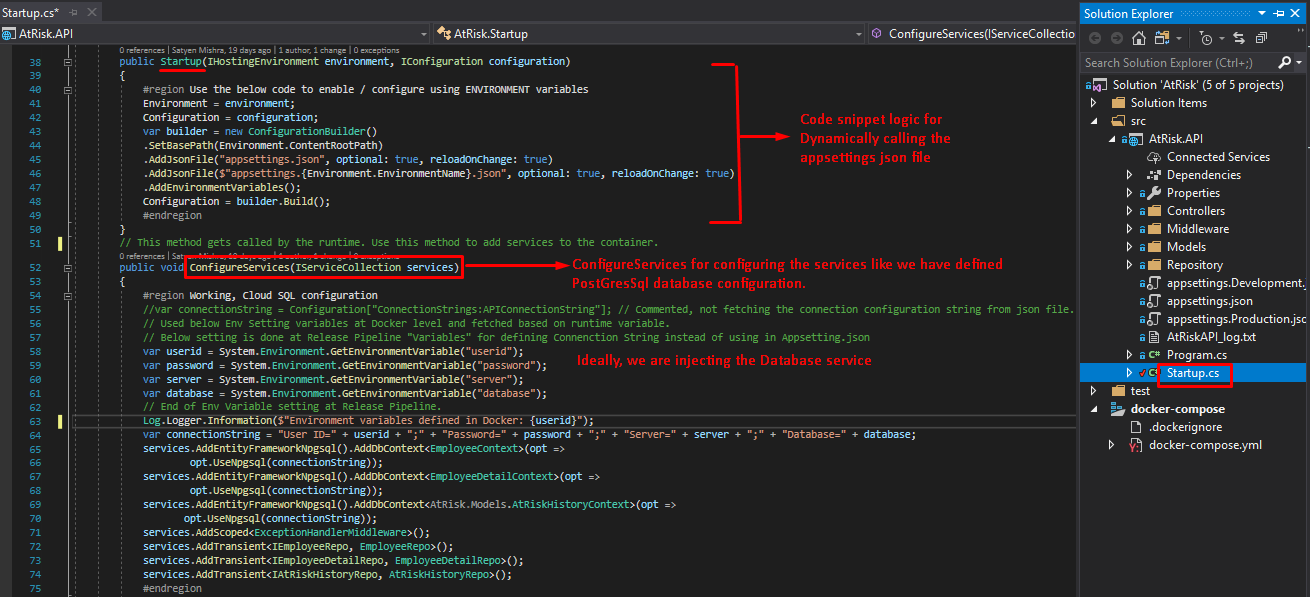
Implementation in Controller
The Microservice should have an endpoint for which a controller is needed, which exposes the HTTP methods to the client as endpoints of the service methods. So, Implement the IRepository interface into the controller class.
Right-click on the Controllers folder and add a new Controller “history” to get the At-Risk history details.
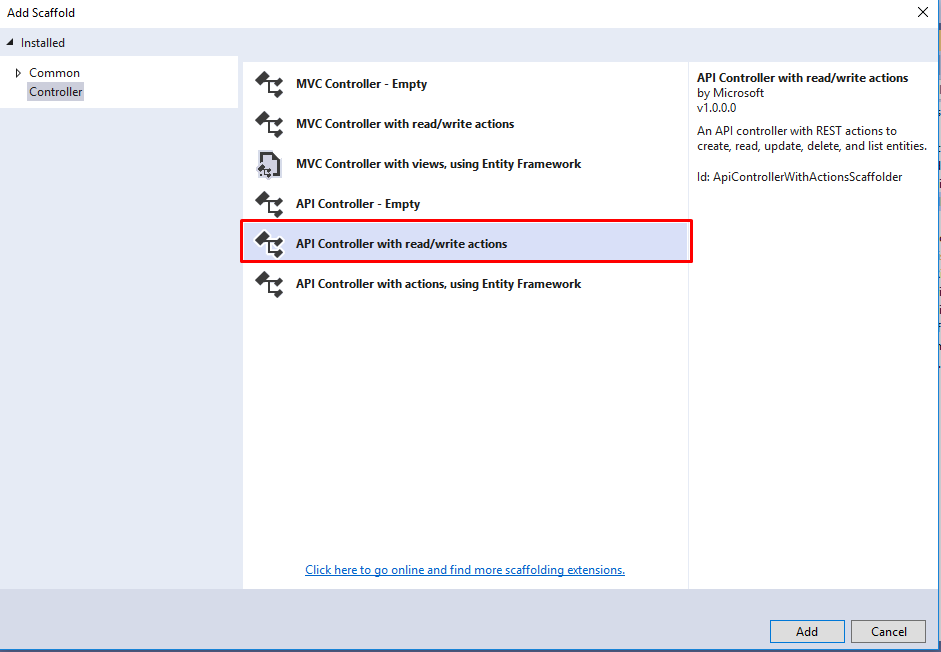
Add below code to call the GetAtRiskEmployeeDetailsAsync method. The basic implementation is shown here for the sake of understanding the concept. The methods could be attribute routed and could be decorated with more annotations as needed.
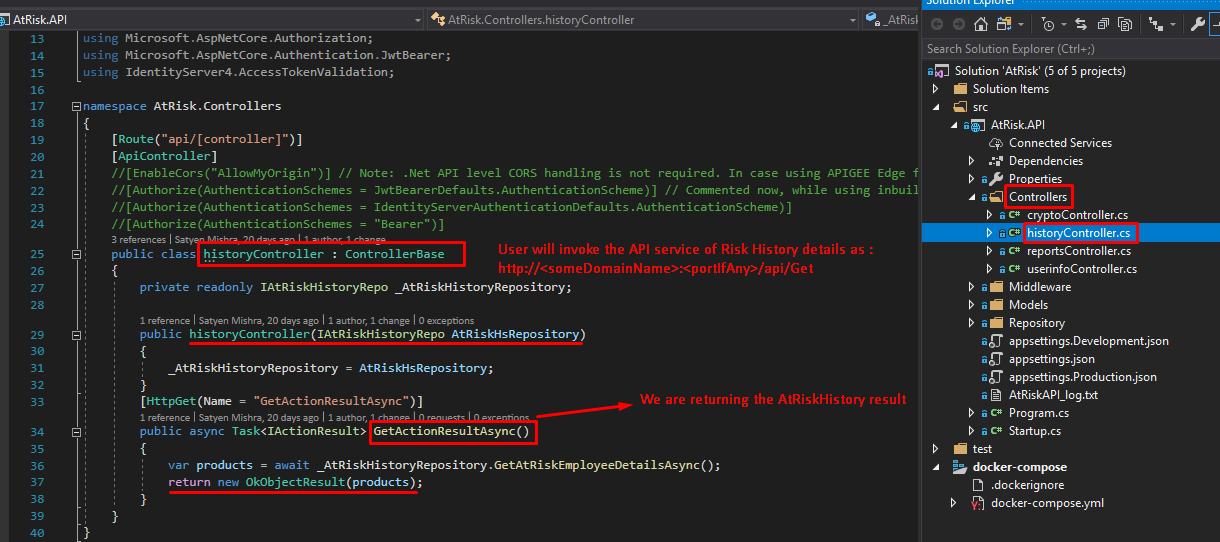
Note: We haven’t used the Entity Framework Core Migrations because this was a database-first approach.
Run the Microservice
Click on the launchSettings.json file for setting the service to get executed, next click F5. The service could be run via IIS Express. For example, Visual Studio default or via Docker container as well. Below are the default setup is shown, however, you can modify as per your requirements.
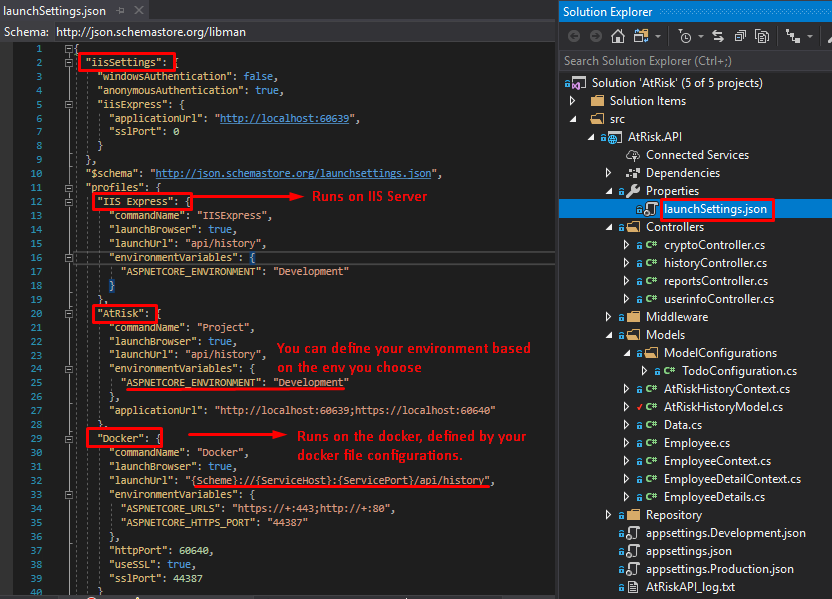
Sometime it might not show any data while running in a browser, it will be blank, but the service could be tested via any API testing client. Here Postman is used to testing the service endpoints. Keep it opened and the application running.

Through Postman, perform a GET request now and two records are shown as a JSON result response.

Creating Docker File, Image and Run the Containerized Service
To create a Docker file, refer to the initial step two of this article which explains how to select Linux as Docker Target OS at the beginning of the project creation.
OR to create later, Right Click on the cs project > Add > Docker Support.
You can use Docker-Compose in case you are dealing with multiple Docker files. Docker-Compose makes easy to build and run the multiple Docker files on a single go.
To use Docker Compose, Right-click on cs project > Add > Container Orchestrator Support > Select Docker-Composefrom dropdown.
Note: The idea behind the article is to have a simple approach to Dockers, and just deploy and execute the service through Docker Container. I would suggest to separately deep dive more in Docker, Containers and Docker-Compose through their official sites.
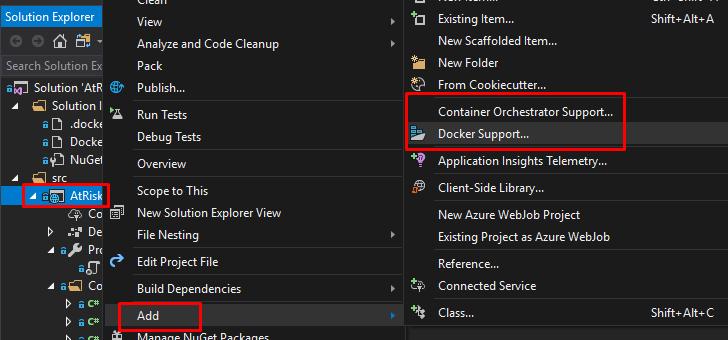
If we select Docker Support to create Docker files the next screen would display Target OS:

If we select Container Orchestrator Support to create Docker-Compose File then the next screen would be:

For this example, we will skip Docker-Compose and only create a Docker file to run and deploy the services. Once the Docker file is created the same will get appended in .csproj file as below:
DockerFileContext defines the relative path of the docker file placed.

Docker file sample:
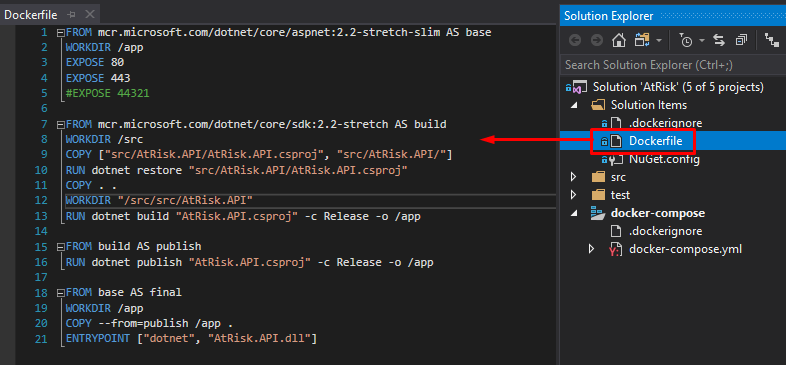
How to Build, Tag and Run the Microservices Using Docker Container Under Multiple Environments?
Running the service could be done via Docker commands to be run in a Docker command prompt and using Visual Studio as well. As soon as the solution is saved, it builds the project under the container and creates a Docker image. All the commands execution can be seen in the output window when the solution is saved.

Open the command prompt in admin mode and navigate to the same folder where the project files are.
In case you want to test the containers in the localhost then run the Docker commands.
The same commands will be used while running for a PROD environment with slight tweaks.
docker images >> To checklist of images

docker build -t api . >> Build the docker file
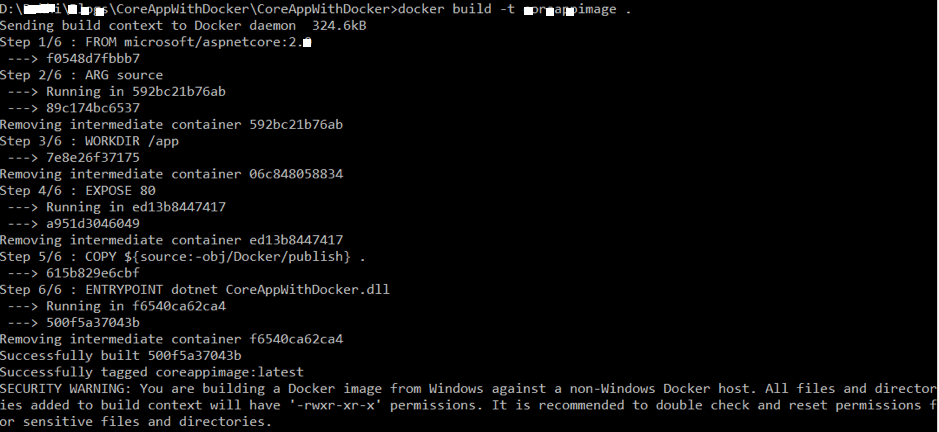
docker tag api:latest repoName/api:v0 >> Tag the image
docker run -d -p 60639:80 api:latest — environment="Development">> Run and containerize the image with port numbers under multiple environments. -d is daemon mode (runs on the background), and -it is the interactive mode (we can debug and check logs).
docker ps a >> To checklist of running containers.

docker container stop/rm <container name or id>>> To stop and remove the list of running containers
Either we can run the Docker containers using the above commands or we can execute through Visual Studio.
Run the application with Docker as an option shown below:

Using the container port, now we can invoke the API service in the same way we approached for IIS Server.
Conclusion
Microservice is a service built around a specific business capability, which can be independently deployed and is called bounded context. This article on Microservices is focused on what Microservices are and their advantages over monolithic services architecture. The article describes a simple step by step on how to develop a Microservice using ASP.NET Core and run it via IIS and Docker container. Likewise, the service can have multiple images and can be run on multiple containers at the same point of time and deploy to multiple environments.
This is just a simple article about creating micro-services using .Net Core. If you have any questions about articles or content, please comment down to make it better. Your comment matters to improve and share knowledge.
Thanks and Happy Knowledge sharing !!
Further Reading
If you enjoyed this article and want to learn more about ASP.NET, check out this collection of tutorials and articles on all things ASP.NET.
Opinions expressed by DZone contributors are their own.

Comments